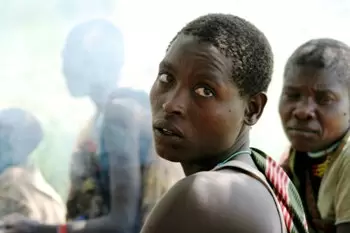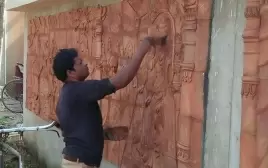Around the world, tribal problems present the same picture
17-January-2014
Vol 5 | Issue 3
This special photographic essay put together by Survival International (www.survivalinternational.org), a human rights organisation campaigning for the rights of indigenous tribal peoples, highlights the lives of some inspiring tribal women, from different corners of the globe, who are making a difference to their communities. Text by Joanna Eede.
‘I WILL NOT LEAVE MY NIYAM RAJA’
To be a Dongria Kondh woman of the Niyamgiri hills in Odisha state, India, is to be intimately connected to one’s homeland; they have lived successfully in the lush forested hills with their perennial streams and giant jackfruit trees for millennia. They call themselves Jharnia, or, protectors of streams.
 |
|
Dongria Kondh women (Photo: Taylor/Survival International)
|
For the past 10 years Dongria Kondh women have been standing shoulder to shoulder with Dongria men to protect Niyamgiri against devastating plans by Vedanta Resources to construct an open-pit bauxite mine on their most sacred mountain, Niyam Dongar, the ‘mountain of law’.
At one time they formed a human chain around the base of the mountain to prevent Vedanta’s bulldozers from destroying it.
In August 2013 the Dongria Kondh overwhelmingly rejected plans by the British mining giant for an open-pit bauxite mine in their sacred hills, in an unprecedented triumph for tribal rights.
Many of the Dongria’s key figures – those who have been protesting loudly, travelling over 1,600 kilometres to Delhi, demanding that police release arrested leaders – have been women.
Though few still believe that the mine will be given the green light the Dongria Kondh women are as defiant as ever.
‘We will not give our forests to anybody. And even if you threaten to kill us, we will carry on living here peacefully. I will not leave my Niyam Raja until I die,’ said one. All of the women are prepared to go to jail for this.
‘I AM AN INNU AND THIS IS MY HOME’
Elizabeth ‘Tshaukuesh’ Penashue is an 84 year old Innu woman from Sheshatshiu in Labrador [Canada].
 |
|
The Innu place (Photo: Elizabeth Penashue)
|
For many years she has led a spring-time walk through the local Mealy Mountains, with the aim of reconnecting the younger Innu generation with the lands they have lived on for nearly 8,000 years.
‘I don’t want to see my children lose everything. I don’t want them to lose their Innu identity, culture and life,’ she told a Survival International researcher.
‘Before I’m gone, I have to teach the children. If nobody teaches our children, what will they think when they grow up? Will they think ‘I’m not Innu, I’m a white person’?’ she added.
‘It is important to know who you are. I am Innu. The country is my life. I’m proud that I was born in a tent. No nurse, no doctor. My father helped my mother give birth.
‘When I walk into the country, I feel like I’m going home, into my own place. The Innu place.’
THE LAST OF AFRICA’S HUNTER-GATHERERS
Between the soda waters of Tanzania’s Lake Eyasi and the ramparts of the Great Rift Valley live the Hadza, a small tribe of approximately 1,300 hunter-gatherers: one of the last in Africa.
 |
|
Africa's hunter-gatherers (Photo: Joanna Eede/Survival International)
|
The Hadza have probably lived in the Yaeda Chini area for millennia. Genetically they are one of the ‘oldest’ lineages of humankind. Over the past 50 years, however, the tribe has lost 90 per cent of its land.
The Hadza value equality highly, recognising no official leaders. As a result, Hadza women have a great amount of autonomy and participate equally in decision making with men.
LEONOR ZALABATA SHARES HER MYSTICAL WISDOM
The Sierra Nevada de Santa Marta mountains in northern Colombia form the world’s highest coastal range; the snowy peaks that tower over cloud-forested slopes and melt-water rivers are sacred to the indigenous Arhuaco people.
The Arhuaco have lived here for centuries. To them, the Sierra Nevada is the heart of the world; they call themselves the ‘Elder Brothers’, and believe that they have a mystical wisdom and understanding, which surpasses that of others.
 |
|
Living in the 'heart of the world' (Photo: Survival International)
|
Leonor Zalabata, an Arhuaco leader who has worked tirelessly in defence of the Arhuaco and the rights of Colombia’s 102 indigenous peoples, first met Survival International during the 1990s when left-wing guerrilla insurgents set up camp on the Arhuaco’s land and subjected them to a period of brutal violence. Many Arhuaco leaders were killed.
Despite the continuing dangers, Leonor has dedicated her life to speaking out against abuses against Colombian Indians. She has worked with the UN Working Group for Indigenous Peoples’ and the UN Permanent Forum for Indigenous issues.
‘The Sierra Nevada de Santa Marta … is the heart of the world,’ she says. ‘Here is where our spirits rest and remain.
When a girl is born, in our culture we say that the mountain laughs and the birds cry.’
SIBERIAN NENETS WOMEN LOVE THEIR REINDEER
A Nenets woman stands outside her chum (tipi) in Siberia’s Yamal Peninsula. Her homeland is a remote, wind-blasted place of permafrost, serpentine rivers and dwarf shrubs; the reindeer-herding Nenets people have migrated across it for over a thousand years.
 |
|
A Nenets woman (Photo: Steve Morgan/ www.stevemorganphoto.co.uk)
|
During the winter, the women endure temperatures that plummet to -50C. This is when most Nenets graze their reindeer on moss and lichen pastures in the southern forests, or taigá.
In the summer months, when the midnight sun turns night into day, the women pack up camp and migrate north with their families.
Today, their ways of life are severely affected by oil drilling and climate change. Their migration routes are now affected by the infrastructure associated with resource extraction; roads are difficult for the reindeer to cross and they report that pollution threatens the quality of the pastures.
‘The reindeer is our home, our food, our warmth and our transportation,’ said a Nenets woman. - Women's Feature Service















